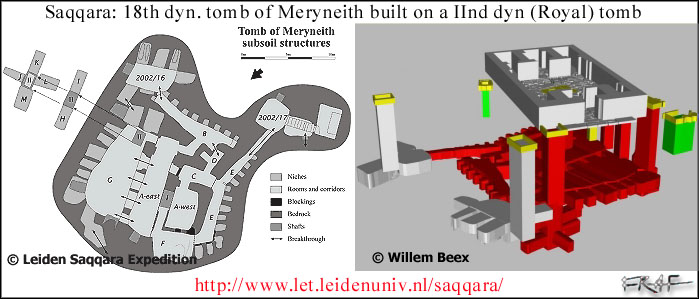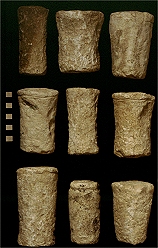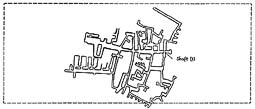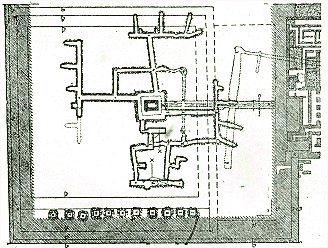(This is a cache file from Leiden University Saqqara on-line website LINK 1 - LINK 2)
A new Royal Tomb in Saqqara...Listed here are the reasons why we are convinced that the substructure belonged to a second Dynasty King. Last year Francesco Raffaele, an Italian student of Egyptology, already suggested on his website that a royal tomb might be involved... 1) stone vessels and pottery indicate a date at the end of the Second Dynasty. 2) the plan of the subterranean complex differs from that of contemporary private tombs at Saqqara: the latter have a stairway (but no shaft), a long corridor with side-rooms (but no galleries with niches), and a clear end room for the burial with adjacent latrine and bathroom. 3) there are closer parallels with the two known royal tombs of the Second Dynasty at Saqqara: that of Hotepsekhemuy and Raneb (under the pyramid temple of Unas) and the other of Ninetjer (under the Unas causeway). Both tombs have been attributed to this period on the basis of seal impressions. The tombs are much larger than contemporary private tombs, and the Ninetjer tomb has a shaft and galleries with niches as part of the 50 x 50 m large complex. 4) contemporary private tombs are exclusively situated in the north of the Saqqara plateau (north of the Teti pyramid). The southern part was reserved for kings: the two above-mentioned tombs near the Unas pyramid, a deep rock-cut trench east of the Unas pyramid, and the large rectangular enclosures west of the pyramids of Djoser and Unas (especially the so-called Gisr el-Mudir). The access route to this royal cemetery was formed by the wide Wadi Abusir which runs past the Saqqara Serapeum. The rock-cut trench may have served as a secondary access. 5) the subterranean complexes seem to decrease towards the end of the Second Dynasty. Ninetjer is already noticeably smaller than Hotepsekhemuy, and the same tendency is observed in contemporary private tombs. This means that it need not surprise us that the tomb of a successor of Ninetjer would be again smaller, in this case about 15 x 15 m. Moreover, the three successors of Ninetjer (Weneg, Senedj, and Nebnefer) are hardly known and may have ruled for a short reign only. Possibly, the new tomb at Saqqara belonged to one of these three kings. 6) Galleries with lateral niches around a central shaft remain a characteristic of royal tombs even after the Second Dynasty, as shown by the funerary complexes under the Step pyramids of Djoser, Sekhemkhet, and at Zawiyet el-Aryan.
|

The joint expedition of the Leiden
Museum of Antiquities and the Faculty of Archaeology/Department of Egyptology
of Leiden University resumed its fieldwork in the Saqqara New Kingdom
necropolis on January 15th, 2002. The site was closed on February 28th.
The work of the Dutch mission was concentrated on the tomb of Meryneith, Greatest
of Seers of the Aten, which was discovered last year. The objectives of the
present season were the following:
1. Clearance of the exterior walls: a trench of c. 3 m. wide was cut around the superstructure of the tomb,in order to relieve the pressure of the sand and also to check the condition and the architectural structure of the exterior walls. In the west, the base and the two corners were found of a mud-brick pyramid originally enveloping the central chapel. Along the north, west, and south walls, the Expedition uncovered various limestone or rubble floors of several New Kingdom tombs and their shafts. From the drystone walls surrounding these shafts, a number of relief blocks or architectural fragments were retrieved. These included at least five fragments originally belonging to Meryneith's tomb. East of the tomb, the Expedition tried to trace the full extent of Meryneith's forecourt. This is bordered on the north and south sides by mud-brick walls, the latter with four stela niches. The south wall ends with a protruding jamb at a distance of about 12 metres east of the tomb's facade whereas the north wall seems to continue beyond this point. Otherwise, the forecourt was found to contain two more drystone shaft rims, as well as a square mud-brick shaft (?) (footholds in its interior), that may be Coptic in date. On the south side of the tomb, the base of the exterior wall has not been reached yet. The area is still covered by a tafl floor roughly 1 metre above the pavement of the courtyard.

2) Investigation of the substructure:
the 6 metres deep shaft and the upper level of the subterranean chambers had
already been explored in a summary way in 2001. Now, the whole complex could
be completely emptied. Originally, it seems to have consisted of four galleries
with shallow lateral niches (of which two galleries are still present in their
original execution and with part of the original blocking of the niches) forming
a square around the shaft. About seventy limestone dummy vessels, several
Nile silt jars, and many sherds of pottery, alabaster and other stones indicate
a 2nd Dynasty date of this phase. Recent analysis
of the material has indicated that it concerns a royal tomb!
During the New Kingdom, a single tomb-chamber was added at the end of a short
corridor to the north of the shaft. Only some sherds of pottery and three
inlays for wooden coffins date to this period. All the other funerary objects
were presumably removed during the Late Period (c. 5th century BC), when the
subterranean complex was reused for the burial of numerous mummies. No (unambiguous)
remains of Meryneith's burial have been preserved. The complex was considerably
extended towards the east and west, new shafts broke in through the ceilings,
and an inner shaft with six additional niches was sunk in one of the floors.
Later, tomb robbers made several breakthroughs to adjacent tombs; one of these,
dating to the New Kingdom, was emptied by the Expedition, another Late Period
complex was partly excavated. Both these tombs contained a number of New Kingdom
relief blocks or stela fragments that had fallen down the shafts or were reused
as covering slabs for burial pits.
3) Copying of wall decoration: a good start could be made with the facsimile drawing of the relief decoration of Meryneith's tomb. The extent slabs of the courtyard and central chapel could almost be finished. Moreover, a considerable number of loose blocks and fragments could be recorded as well. The remaining reliefs and the paintings in the four corner chapels will be dealt with in the season 2003.
4) Feasibility study of restoration: contact was established with the architect Nicholas Warner, who was asked to provide a preliminary design for the restoration of the tomb's superstructure. This project especially concerns the re-erection of the peristyle, roofing the vestibule and central chapel, and providing the necessary security for an in situ display of the reliefs. These designs will be presented to the SCA by the end of June.
5) Others: Apart from these main
objectives, Prof. Strouhal managed to finish the study of the skeletal material
found in a Ptolemaic burial complex during the season 2000; Dr van der Vin
studied the coin hoard found in the same complex and established its most
feasible date to be the reign of Ptolemy XII. The Expedition's ceramicists,
besides collecting the pottery of the present season, worked on the recording
and drawing of pottery from former seasons. The Expedition renewed some of
the protective panels in front of reliefs in the tombs of Horemheb, Tia, and
Maya. A new storeroom was built on the site for the relief blocks and objects
found
during the seasons 2001-2002.
Acknowledgements:
The excavation team consisted of Dr Maarten J. Raven and
Dr Rene van Walsem (joint field directors), Dr Barbara G. Aston and Ms Amanda
Dunsmore (pottery specialists), Prof. Eugen Strouhal (anthropologist), Drs
Willem Beex (surveyor), Ms Dorothea Schulz (draughtswoman), Ms Anneke de Kemp
and Mr Peter Jan Bomhof (photographers), Mr Christian Greco and Ms Heleen
Wilbrink (field assistants). ). Dr Jos van der Vin (numismatist) and Dr Rob
J. Demaree (hieraticist) joined the team for 2 weeks each. The fieldwork was
carried out in close collaboration with Mr Adil Hussein Muhammad (Director
of Saqqara) and Mr Sami el-Hoseiny (Chief inspector) and was supervised in
the field by the Inspector Mr Osama Abd-es-salam el-Shimy. The Expedition
wants to express its gratitude to Prof Gaballa A. Gaballa (Chairman of the
Supreme Council for Antiquities), to Dr Zahi Hawass (Director of Giza and
Saqqara),and to the members of the Permanent Committee. We are indebted to
the Director and staff of the Netherlands-Flemish Institute in Cairo (NVIC)
for all their assistance, and to the Egypt Exploration Society for granting
us the use of the Saqqara dighouse. Finally, we wish to thank the following
persons and institutions
for their financial or logistic support: the Netherlands Organisation for
Scientific Research (NWO), Dr Karel Innemee (Deir Musa el-Eswed excavations),
Archaeological Research Consultancy at Groningen, and Mr R.J.M. Straathof
(Koers-Kompas nv).

